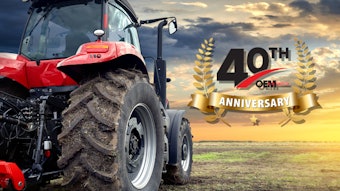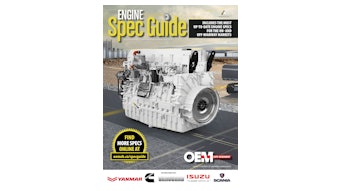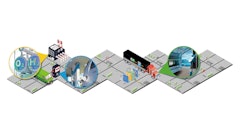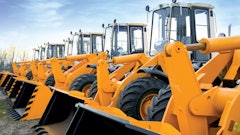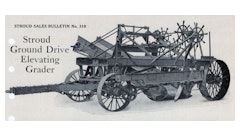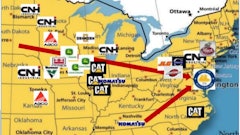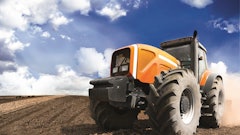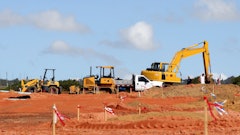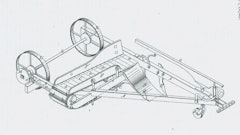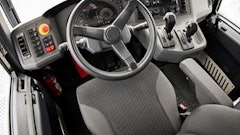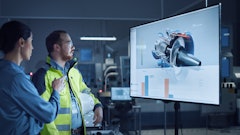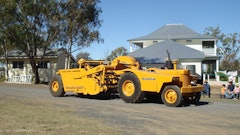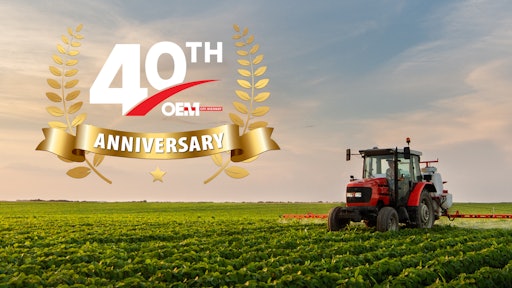
As OEM Off-Highway marks its 40th anniversary in 2024, we reflect on the incredible journey the brand — and the industry as a whole — has had over the past four decades. From humble beginnings to becoming a staple of the industry, OEM Off-Highway has been a platform for showcasing innovation, excellence and progress.
To mark this significant milestone, we're exploring both the past and the future. In our continued coverage, we take a look at some of the more sizeable shifts and track the trends that have helped to shape off-highway equipment as we know it today.
Anniversaries tend to bring out interesting retrospectives for any industry. For OEM Off-Highway, as the first official editor of the publication, I’ve been tapped to look back on the early days and explore the start of the brand’s expanded content journey.
Originally created as a publication providing new product news to the off-highway industry, creation amounted to searching and editing press releases, and running the occasional guest column. However, the manufacturing landscape was changing and there was a growing need for information to help companies explore new approaches or take on innovations in manufacturing.
Dear reader, think back to 1984 and what was happening in agriculture and construction. Economic forces were pounding on both industries, and in fact agriculture was pushed through a kind of depression. The construction industry was thriving, but market forces were at work there as well.
As often happens, trends in the on-highway business of trucks and cars trickles down to the off-highway industry. Phrases like “just-in-time” or “Kanban” were being added to the lexicon of manufacturers large and small. And it was into this time, that a new kind of content was needed.
I was involved editing Farm Equipment, a sibling publication at the time, connecting with dealers and the industry on a number of issues from bringing in computer accounting tools to handling Human Resource issues. For OEM Off-Highway, the charge was different: focus on the forces impacting manufacturing and share stories of companies achieving success.
The focus for both publications at the time, and continues today, was the reader. And those readers needed more than to know “what’s new.” Sure, new product information remained part or the mission, but it was time to bring in a different kind of reporting.
W. Edwards Deming was having an impact across both on-highway and off-highway production. World Class Manufacturing was gaining traction as part of the evolution. The days of piling up raw material in case it was needed, evolved into “work in process” analysis and connecting that to “just in time” tactics to cut the cost of machine manufacture.
Those early new stories dug into ergonomics, expanded equipment testing and more. Across the off-highway industry, companies were tightening their belts while working to maintain equipment quality. It wasn’t easy, but new approaches were coming from robotic welding to enhanced parts management.
Add in the new tech tools to speed product development. Finite element analysis alone changed the way engineers viewed the materials needed for equipment. They could design a machine using thinner steel, or even advanced plastics, in some areas to cut weight and cost while still maintaining equipment durability and quality.
One whole goods manufacturer that took on that challenge was Case IH. The launch of the Magnum tractor in 1987 caught everyone’s attention and not just because it was the first new product for a merged company. The tractor had “plastic” side panels, and many questioned the long-term durability of that material choice. I’ve seen my share of 7100 series tractors lately and those panels look just fine.
New materials were coming to the industry in new ways, and it was a joy to share that information with OEM Off-Highway readers.
I left the editor role in later 1987 to pursue other opportunities. In the early 1990s, I returned on a freelance basis to help explore topics including such trends as the early rise of ISO 9000. Manufacturing keeps evolving and I enjoyed helping share that information to readers.
I’m thrilled when I tour a factory today, and I’ve toured dozens, and see the tactics I wrote about in the 1980s and early 1990s being deployed. I can see how companies work with just-in-time tactics even in the face of COVID and what that did to supply chains. And it’s interesting to see how whole goods inventory management has evolved as well.
The off-highway manufacturing industry is a vibrant business deploying tools and technologies to enhance product quality. The industry has found ways to maintain margins and bring new tools to vital industries that gird the infrastructure of the country from roads and bridges to the nation’s farm fields.
OEM Off-Highway is celebrating a milestone. But instead of looking back, it’s time to look forward and explore how new technologies like artificial intelligence and automation will shape this ever-changing industry. The tools and technologies being deployed in off-highway equipment would amaze the uninitiated. Keep on, keeping on.
For more on OEM Off-Highway's 40th anniversary, check out our additional and extended coverage.
